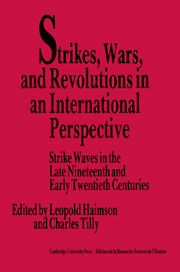 Strikes, Wars, and Revolutions in an International Perspective
Strikes, Wars, and Revolutions in an International Perspective Book contents
- Frontmatter
- Contents
- List of contributors
- Preface
- Part I Introductions
- Part II Models and realities
- Part III Workers in metal-processing enterprises in comparative perspective
- 11 From the mechanic to the metallo
- 12 Strikes of machinists in the United States, 1870–1922
- 13 The political economy of British engineering workers during the First World War
- 14 The rationalization of class struggle: strikes and strike strategy of the German Metalworkers' Union, 1891–1922
- 15 Scientific management and the changing nature of work in the St. Petersburg metalworking industry, 1900–1914
- 16 Structural processes of change and changing patterns of labor unrest: the case of the metal-processing industry in Imperial Russia, 1890–1914
- 17 Social characteristics, attitudes, and patterns of strike behavior of metalworkers in Italy during the First World War
- Part IV The effects of short-term variation
- Part V Conclusion
11 - From the mechanic to the metallo
Published online by Cambridge University Press: 25 March 2010
- Frontmatter
- Contents
- List of contributors
- Preface
- Part I Introductions
- Part II Models and realities
- Part III Workers in metal-processing enterprises in comparative perspective
- 11 From the mechanic to the metallo
- 12 Strikes of machinists in the United States, 1870–1922
- 13 The political economy of British engineering workers during the First World War
- 14 The rationalization of class struggle: strikes and strike strategy of the German Metalworkers' Union, 1891–1922
- 15 Scientific management and the changing nature of work in the St. Petersburg metalworking industry, 1900–1914
- 16 Structural processes of change and changing patterns of labor unrest: the case of the metal-processing industry in Imperial Russia, 1890–1914
- 17 Social characteristics, attitudes, and patterns of strike behavior of metalworkers in Italy during the First World War
- Part IV The effects of short-term variation
- Part V Conclusion
Summary
If the workers of the metal-processing industry, who are largely absent from the strike scene as late as the 1880s, became by the turn of the century major actors in labor unrest, it is first and foremost because of the structural transformations of production that turn metal processing into a key sector of industry. The introduction in means of transportation of mechanical equipment involving the use of coal, and eventually oil, gives a major impulse to the development of mechanical enterprises and shipyards. From the Urals to the Appalachians, the numbers of workers employed in metal-processing and mechanical enterprises swell during these two decades: in St. Petersburg, from 21,000 in 1884 to 60,000 by 1900; in the United States, from 55,000 workers employed in mechanical enterprises in 1870 to 840,000 by 1920. These comparative indices illustrate the transformation of the industrial landscape that provides the common background for the case studies presented here.
Besides these patterns of rapid growth, these case studies of the metal industry bring out another common feature: the changes in organization that, with different degrees of rapidity and scope, metal-processing enterprises undergo everywhere: from Detroit to St. Petersburg, from Milan to Sheffield and Essen. At the beginning of the 1880s, at least in Western Europe, the metalprocessing industry largely consists of a myriad of small enterprises, employing workers with a wide range of skills and enjoying a considerable degree of autonomy, which they manage to safeguard by maintaining a certain degree of control of the labor market, control over the dissemination of their skills as well as of the levels of remuneration paid for them.
- Type
- Chapter
- Information
- Strikes, Wars, and Revolutions in an International PerspectiveStrike Waves in the Late Nineteenth and Early Twentieth Centuries, pp. 261 - 268Publisher: Cambridge University PressPrint publication year: 1989


